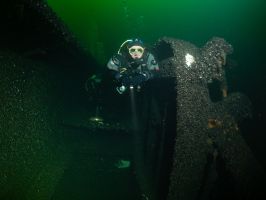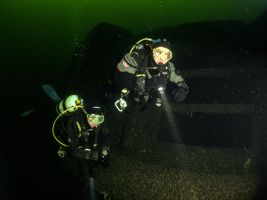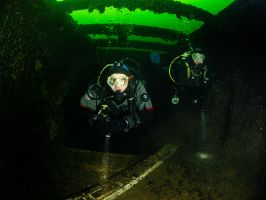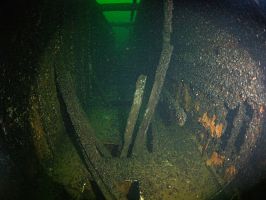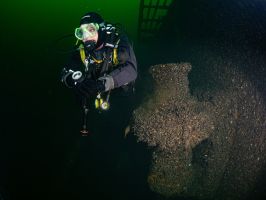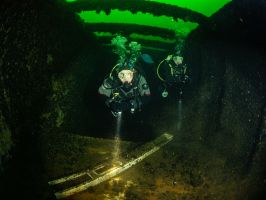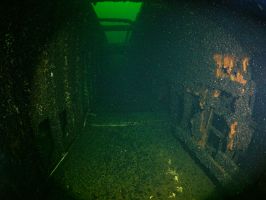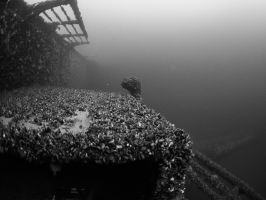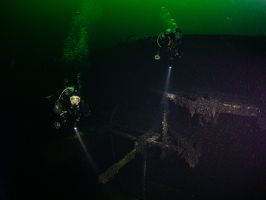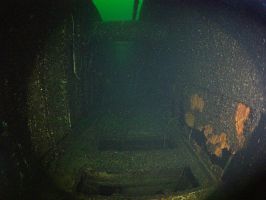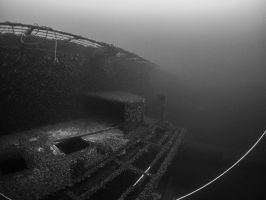Diving on site
It's worth noting in the beginning that one dive is not enough to see Buchner in its entirety. In order to know this huge wreck you should arrange at least a couple different dive sessions.
The ship lies on its starboard side so the most interesting things can be sighted while swimming along the deck.
Diving starts on the left, shallower side of the wreck. The depth here is about 25 meters. To the port side leads down line but if it's broken at the given moment the skipper will try to drop a shot with weight attached to help you get to the site
The shallowest attractions are two rows of galleries running alongside the vessel.
The wider of them, which used to be on the upper deck resembles a sizable canyon and inside it two divers can swim comfortably together.
At the stern side, between depths of 32 and 37 meters one can see capstans and windlasses as well as an open hold area but the most impressive are the gigantic rudder blade and the steering shaft, sadly without the propeller. About a third of the way from the stern begins a grand superstructure with multiple windows. A huge stack leans against the seafloor and you can also marvel at the air vents high above the superstructure that lead to the engine room.
The bow area is also swarming with interesting objects at a similar depth. - close to the edge of the superstructure with the huge windows and the area once occupied by the bridge lies a grand loading crane. On the port side, in a later hawsehole lies a humongous anchor. Closeby you can see the anchor’s windlass. On the bottom in front of the bow creeps the chain and steel line used for hauling the ship. Beside the cut end of the line lies a big, mysterious spool.
Georg Büchner is a dream wreck both for technical and recreational divers. The former can plan long dives which will definitely not be boring, while the latter can enjoy the view of the huge, very impressive wreck which lies within the recreational limits - the depth being less than 40m.
Above the ship you can experience light to moderate current. The visibility is oftentimes more than 15m which adds to the beauty of the wreck
Story
This ship’s story lasted 73 whole years. It was built in Belgium under the name Charlesville where it connected Antwerpia and Kongo, visiting ports like Tenerife, Lobito and Matadi on the way. These cruises would often last a couple of years, even after Kongo declared independence. In 1957 the ship’s engine went under repair.
In 1967 the ship was sold to VEB Deutsche Seerederei, a company from the German Democratic Republic. It got a new name Georg Büchner to commemorate a famous german revolutionary and writer. During the next 10 years the ship served training purposes and the cruises hosted, apart from 100 crewmembers, about 150 sailing trainees.
In 1977 the ship was withdrawn from sea service and after the necessary renovations in the Szczecin Gryfia shipyard it came back to Germany. What’s interesting is that most of the equipment, including the engine remained functional but the ship couldn’t sail on its own anymore. Until 1998 it remained a training vessel for educational and research purposes, playing an important part in training new generations of German sailors. In 2001 it was docked in Rostock, taking on the function of a floating hotel.
In 2012 against protests and accompanied by a scandal, the ship was sold as scrap. The protesters were critiquing he decision as violating the memory of the classical liner nautical history. Büchner was sold for 800 000 euro, and for its last voyage to Klaipėda it was hauled by a Polish tugboat Ajaks on May 28 2013. On the third day of the haul the ship started dangerously leaning on its side which was noted by the captain at 18:25. The ship sank around 20:25 in still mysteriously unknown conditions, 6 miles from the port in Władysławowo on Polish territorial waters.
Technical specifications:
A cargo/cruise ship constructed in Hoboken near Antwerp, Belgium in John Cockerill shipyard.
The keel was put in place in 1950 and the ship started its service in 1951.
153,67 meters long, 19,76 meters wide, loaded draught of 8,38m, gross tonnage of 10 946 tons, and the dead weight of 9 128 tons. The ship had six cargo holds that could keep between 5 to 40 tonnes and were operated by 18 cranes. It could hold 248 passengers.
The ship was powered by a Burmeister & Wain turbine of 9 250 horsepower. The top speed was 16 knots.
Text by: Bartosz Słaboń
Translation: Szymon Rydzewski
If you have additional info on the ship or would like to correct the Information on the site - please contact us.



